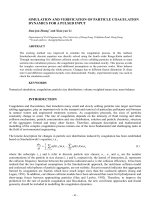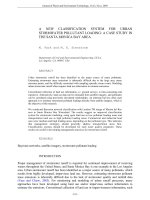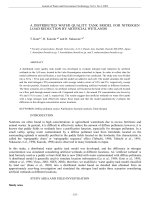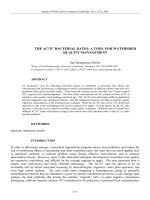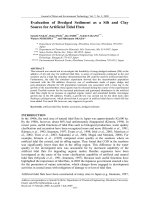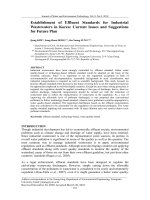CGrand Challenges: A Strategic Plan for Bridge Engineering
Bạn đang xem bản rút gọn của tài liệu. Xem và tải ngay bản đầy đủ của tài liệu tại đây (104.78 KB, 21 trang )
Grand Challenges:
A Strategic Plan
for Bridge Engineering
AASHTO Highway Subcommittee on
Bridges and Structures
June 2005
Grand Challenges:
Strategic Plan for Bridge Engineering
1
INTRODUCTION
BACKGROUND
The Highway Subcommittee on Bridges and Structures (HSCOBS) of the American
Association of State Highway and Transportation Officials (AASHTO) has long recognized the
benefit of research in helping its members meet their responsibility to design and manage
the nation’s highway infrastructure. Because of this recognition, HSCOBS strives to identify
ways to fulfill the business needs of its members, and, to that end, annually reviews
research problem statements and recommends selected statements to the AASHTO
Standing Committee on Research (SCOR) for consideration for funding under the National
Cooperative Highway Research Program (NCHRP). In addition, other research needs are
addressed by Federal, State and industry-sponsored research and development programs.
2000 WORKSHOP
Because of this review and recommendation process, the subcommittee has obtained
funding for various NCHRP projects that have benefited the bridge community. It became
apparent to the subcommittee that a more structured procedure for prioritizing research
was needed. A workshop was conducted February 14-16, 2000 in Irvine, California to
develop a strategic plan for bridge engineering. Participants included AASHTO State Bridge
Engineers, the Federal Highway Administration (FHWA), academics, consultants, and
industry representatives. The information developed in the workshop represented a
consensus of the participating bridge engineering professionals. The strategic plan assisted
HSCOBS in identifying and prioritizing the major themes for a coordinated national bridge
engineering agenda. HSCOBS has used the resulting agenda to evaluate and prioritize
research problem suggestions ensuring a quality-based research program aligned with
HSCOBS’ needs.
The product of the original workshop is six “thrust” discussions. Each thrust focuses on a
specific business need of the AASHTO bridge engineers. The unprioritized thrusts are as
follows:
• Enhanced Materials, Structural Systems, and Technologies;
• Efficient Maintenance, Rehabilitation, and Construction;
• Bridge Management;
• Enhanced Specifications for Improved Structural Performance;
• Computer-Aided Design, Construction, and Maintenance; and
• Leadership.
Each thrust discussion starts with a paragraph giving general background on the thrust. A
brief statement of the “business need” that would be satisfied with accomplishment of the
thrust follows. After listing the thrust’s objective, the thrust discussion concludes with a list
of “building blocks” (i.e., products or processes that must be available to satisfy the
business need).
A list of research areas that complement the business needs of HSCOBS follows the “thrust”
discussions in Appendix A. This list is included solely to illustrate the range of researchable
topics that are of interest to bridge engineers.
Grand Challenges:
Strategic Plan for Bridge Engineering
2
2005 WORKSHOP
The 2000 report is a working document. Thrusts and business needs are dynamic—they
must be continually reviewed and revised to reflect the ever-changing societal and technical
environment within which the highway system exists. HSCOBS is fully committed to the
continued maintenance and improvement of this document and to applying the contents to
the identification and prioritization of research. As such, a second workshop was conducted
April 18-20, 2005, in Woods Hole, Massachusetts, to refine the 2000 strategic plan.
Participants included AASHTO State Bridge Engineers, the Federal Highway Administration
(FHWA), academics, and consultants. The group included the Transportation Research
Board (TRB) Structures Section chairs.
The products of this workshop are a focused set of critical problems extracted from the
2000 strategic plan that, if solved, would lead to significant advances in bridge engineering,
called “grand challenges” that build upon the thrusts of the 2000 plan. The prioritized grand
challenges are:
• Extending Service Life,
• Optimizing Structural Systems,
• Accelerating Bridge Construction,
• Advancing the AASHTO Specifications,
• Monitoring Bridge Condition,
• Contributing to National Policy, and
• Managing Knowledge
Each “grand challenge” is defined through a brief statement of the challenge and anticipated
outcome, and discussions of the practical importance, the technical importance, and the
readiness of the challenge to be solved. Finally, lists of important activities/research areas
and minimum measures of success, called benchmarks, are included. The benchmarks are
grouped by the time in which they should be accomplished to insure the solving of the
challenge: short term (in 2-3 years), mid-term (in 4-5 years) and long term (beyond 5
years.) The benchmarks can also be viewed as a guide to implementation.
At their 2005 annual meeting in Newport, Rhode Island, the AASHTO HSCOBS adopted the
report of the workshop as their strategic plan for bridge engineering. The detailed plan
follows.
Grand Challenges:
Strategic Plan for Bridge Engineering
3
GRAND CHALLENGES:
A STRATEGIC PLAN FOR BRIDGE ENGINEERING
GRAND CHALLENGE 1: EXTENDING SERVICE LIFE
To understand the processes that decrease the serviceability of existing bridges and
highway structures, and to develop approaches to preserve (maintain and rehabilitate) the
existing system by managing these processes.
Anticipated Outcome:
Strategies to extend the service life of existing inventory of bridges and highway structures.
Practical Importance
A significant portion of the nation’s inventory of 590,000 bridges is rapidly approaching the
end of its intended design life. In order to reduce the demands on already strained
construction and maintenance budgets, the option of preservation must be pursued.
Therefore, it is imperative to better understand the processes which reduce service life and
employ innovative methods to extend the life of these structures.
Technical importance
Our nation’s bridges are aging and the increasing traffic volumes and loads that they
experience result in a reduction in their planned lives. The resulting necessary rehabilitation
and replacement results in reduction in the public’s mobility. In addition, owners sometimes
employ methods to solve problems in the short term in response to the public’s increasing
demand for uninterrupted mobility which prove to be deleterious to their structures in the
long term (For example, the application of de-icing agents to facilitate mobility resulting in
reduced service life.). Guidance should be provided to the engineer to provide cost-
effective preventive maintenance and rehabilitation strategies for existing bridges and
highway structures.
Readiness
Advancements in our knowledge of materials, details, components, structures and
foundations, and an increased array of construction materials and methods makes it an
opportune time to develop solutions to extend the service life to solve the problem of
preventing premature deterioration of existing bridges and highway structures.
Important Activities/Areas of Research
Investigation of processes that decrease the serviceability of existing bridges and highway
structures, and cost effective means of preserving the bridge inventory by prescribing
appropriate cost-effective, durable preventive maintenance measures and rehabilitation
methods for:
• BRIDGE DECKS – including quantification of the impact of increased traffic volume
and loads, nondestructive tests, methods for protection against and extraction of salt
ion intrusion, and new materials and techniques for deck construction and repairs
• MAIN LOAD CARRYING MEMBERS – including girder/main member repair and
strengthening methods, methods to eliminate expansion joints and bearings, and
corrosion mitigation techniques including coatings,
Grand Challenges:
Strategic Plan for Bridge Engineering
4
• SUBSTRUCTURES – including methods for corrosion protection and strengthening of
piers and abutments
• FOUNDATIONS – including methods to monitor foundations and detect scour, to
protect and/or strengthen foundations against scour, earthquake and impact
damage, to modify soil (including liquefaction mitigation), to protect salt-water
foundations against corrosion (including identification of aggressive environments),
and to determine the suitable of existing foundations for proposed rehabilitation or
widenings in terms of geometry, integrity and response
Benchmarks
SHORT TERM: identification of the processes which decrease service life, and subsequent
identification of the most effective existing and most promising emerging preservation
(maintenance and rehabilitation) methods to address the identified processes (including
identifications of monitoring devices to determine the optimum time to apply the
preservation methods).
MID-TERM: implemention of specifications, guidelines and trial applications leading to
deployment of the most effective existing methods, and development of the most promising
emerging preservation methods.
LONG TERM: deployment of the most promising emerging preservation methods.
Grand Challenges:
Strategic Plan for Bridge Engineering
5
GRAND CHALLENGE 2: OPTIMIZING STRUCTURAL SYSTEMS
To understand the advantages and limitations of traditional, newer and emerging materials
in terms of safety, durability and economy; and to develop structural systems (optimized
materials, details, components, structures and foundations) for bridges and highway
structures that efficiently employ these and even newer optimized materials to assure a
safe, minimum 75-year service life requiring minimal maintenance.
Anticipated Outcome:
Structural systems which utilize existing and new materials more efficiently in terms of
safety, durability and economy.
Practical Importance
The use of high-performance structural systems in transportation structures has been
demonstrated to result in significant initial and long-term cost savings, and more efficient
construction resulting in less traffic disruption. Nevertheless, to achieve these, and
additional, efficiencies, design and construction standards based on optimized materials,
details, components, structures and foundations must be developed in order to take
advantage of the benefits that can be obtained from these systems. Further, the public
funding of bridges and highway structures represents a significant investment, and,
maintenance activities to mitigate deterioration of bridges are absorbing an increasing share
of this funding. Development of new materials, details, components, structures,
foundations and construction procedures aimed at safety, durability and economy will help
achieve safe, cost-effective, low-maintenance, long-life structures.
Technical Importance
Existing high performance materials, like high performance concrete and steel, and fiber
reinforced polymer composites, are now being more routinely used in bridge and highway
structures for new construction, rehabilitation, and repair. Optimized structural systems can
increase their efficiency. Meanwhile, some of the newer high performance materials and
systems, like self consolidating concrete and ultra high performance concrete for
superstructures and ground improvement techniques for improved foundation performance,
are now maturing and will soon be ready for widespread use. However, in order to use all
of these materials and systems in a structurally efficient, durable and cost effective manner,
research is needed to better characterize their properties and optimize their use, and
develop efficient design and construction systems, standards and details.
Readiness
Existing classes of materials considered high performance are now being regularly used;
new high performance materials are maturing with respect to our understanding of their
properties and how design and construction can take advantage of their properties. The
need exists both in new construction and existing structure rehabilitation for improved and
optimized systems and standards for geotechnical constructions, foundations, and sub- and
superstructures that can reduce cost, increase standardization, accelerate construction and
result in longer-lasting low-maintenance bridge and highway structures.
Grand Challenges:
Strategic Plan for Bridge Engineering
6
Important Activities/Areas for Research
• Characterization and optimization of material properties (including life-cycle
performance) for both existing and newer materials including:
- Traditional, high and ultrahigh performance concretes
- Traditional, high and ultrahigh performance steels (including weld
consumables and corrosion-resistant steels)
- FRP Composite materials
- Geomaterials (including more accurate characterization on in situ soil
conditions), geosynthetic products and ground improvement techniques
- Other new (perhaps yet unidentified) materials
• Optimization of geotechnical and structural systems for safety, durability and cost
based on optimized materials and systems
• Development of appropriate limit state criteria for the use of these materials, details,
components, and structures for adoption into the LRFD Specifications
• Development of reliability-based engineering design properties for soil and rock
• Benefit/cost studies of these optimized structural systems (materials, details,
components, structures and foundations)
• Assessment of real and perceived barriers to deployment of the various elements of
optimized structural systems
Benchmarks
SHORT-TERM: identification of beneficial and achievable material properties (For example,
the high performance steels exhibit greater toughness than traditional bridge steels, yet the
level of toughness required to reduce fracture-critical member requirements has not yet
been quantified.) and structural characteristics for optimized safe, durable and cost-effective
structural systems (For example, jointless bridges systems result in more durable bridges.),
and identification of barriers to deployment.
MID-TERM: development of optimized structural systems with these properties and
characteristics with mitigation efforts toward the identified barriers.
LONG-TERM: deployment of these systems (through standard details and plans, and limit-
state design criteria).
Grand Challenges:
Strategic Plan for Bridge Engineering
7
GRAND CHALLENGE 3: ACCELERATING BRIDGE CONSTRUCTION
To understand the time-restraints, durability and economy of traditional bridge systems and
their construction methods, and the possibilities and limitations of newer accelerated
methods, and to develop enhanced systems and accelerated methods overcoming
traditional time-restraints while maintaining, or enhancing, safety, durability and economy.
Anticipated Outcome:
Strategies to accelerate the construction of safe, durable and economical bridges; both the
construction of new bridges and highway structures, and the rehabilitation of existing ones.
Practical Importance
A quarter of our nation’s 590,000 bridges are currently classified as structurally deficient or
functionally obsolete. Compounding the problem of an aging bridge infrastructure are
increasing construction activities leading to traffic congestion, delays, and work-zone
accidents. The public has lost patience with the many construction projects, especially
when interruptions interfere with their ability to reliably plan their travel time. Innovative
construction methods, materials and systems are needed that reduce on-site construction
time, while ensuring long-lasting facilities. With available funding that covers only a fraction
of the current rehabilitation and replacement needs, strategies are urgently needed to
accelerate bridge construction projects to more economically and effectively address the
public’s demand to "get in, get out, and stay out.” Projects can also be completed while
maintaining traffic capacity, including in some cases no impact to peak traffic. Accelerated
bridge construction results in projects being completed more quickly and therefore impact to
users may be lessened. Nevertheless, the benefits of accelerated construction must be
weighed against the costs. Finally, recent natural disasters and the increasing threat of
terrorism highlight the need for effective hardening and for rapid recovery of the use of our
bridges and highway structures.
Technical Importance
Accelerated bridge design and construction research will advance technology by developing
improved prefabricated structural systems using enhanced details, materials and foundation
systems. The more controlled environment inherent with prefabrication operations facilitates
improved quality for more long-lasting systems. Resulting industry advancements will
include transportation and erection technology (including new ways of
precasting/prefabricating component units) that allows complete bridges to be installed
within hours. Specification developments will ensure increased consistency and quality
assurance with reduced construction timelines. Research will also result in improved
construction work-zone safety strategies and contracting strategies such as
incentives/disincentives that ensure the reduced construction timelines while allowing
greater flexibility in construction.
Readiness
With highway utilization at capacity, system and public demand requires that the quickest
and most efficient construction be done to upgrade the aging infrastructure with more long-
lasting systems. To meet this demand, bridge technology is available today to install
bridges in hours or days rather than the weeks or months typically required. Also, many
states have legislation that mandates minimizing traffic disruption during construction. A
cultural change in the public’s thinking has occurred such that they now expect that we can

